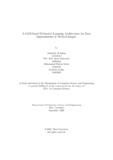| dc.contributor.advisor | Reza, Tanzim | |
| dc.contributor.advisor | Hossain, Dr. Muhammad Iqbal | |
| dc.contributor.author | Al Rakin, Abdullah | |
| dc.contributor.author | Iqbal Majumder, MD. Akib | |
| dc.contributor.author | Kabir, Mohammad Farhan | |
| dc.contributor.author | Arafin, Rudmila | |
| dc.date.accessioned | 2023-04-05T09:13:05Z | |
| dc.date.available | 2023-04-05T09:13:05Z | |
| dc.date.copyright | 2022 | |
| dc.date.issued | 2022-09 | |
| dc.identifier.other | ID: 21341032 | |
| dc.identifier.other | ID: 18201142 | |
| dc.identifier.other | ID: 19101530 | |
| dc.identifier.other | ID: 18301105 | |
| dc.identifier.uri | http://hdl.handle.net/10361/18089 | |
| dc.description | This thesis is submitted in partial fulfillment of the requirements for the degree of Bachelor of Science in Computer Science, 2022. | en_US |
| dc.description | Cataloged from PDF version of thesis. | |
| dc.description | Includes bibliographical references (pages 30-32). | |
| dc.description.abstract | n the medical industry, the availability of precise data limits the scope of deep learn ing applications. Institutional norms restrict hospitals and research facilities owing
to privacy concerns. Therefore, data collection from such sources is unfeasible. Fed erated Learning (FL) is promising in this scenario, but it does not guarantee data
privacy. In this paper, we will use Deep Convolutional Generative Adversarial Net work (DCGAN) and Wasserstein Generative Adversarial Network (WGAN) on an
OCT dataset to demonstrate that the Federated GAN (FedGAN) architecture fails
in these networks due to its innate structure. Additionally, introduce a Distributed
Generative Adversarial Network (Distributed GAN) that collects and distributes the
weights of each temporary GANs on the client side to the main server to tackle the
mode collapse risk of non-iid data. This conserves the optimal distribution of data
to all private discriminators while protecting sensitive individual data. | en_US |
| dc.description.statementofresponsibility | Abdullah Al Rakin | |
| dc.description.statementofresponsibility | MD. Akib Iqbal Majumder | |
| dc.description.statementofresponsibility | Mohammad Farhan Kabir | |
| dc.description.statementofresponsibility | Rudmila Arafin | |
| dc.format.extent | 32 pages | |
| dc.language.iso | en | en_US |
| dc.publisher | Brac University | en_US |
| dc.rights | Brac University theses are protected by copyright. They may be viewed from this source for any purpose, but reproduction or distribution in any format is prohibited without written permission. | |
| dc.subject | GAN | en_US |
| dc.subject | Generator | en_US |
| dc.subject | Discriminator | en_US |
| dc.subject | Federated Learning | en_US |
| dc.subject | OCT | en_US |
| dc.subject | Deep Convolutional Generative Adversarial Network (DCGAN) | en_US |
| dc.subject | Wasserstein GAN (WGAN) | en_US |
| dc.subject | Distributed GAN | en_US |
| dc.subject | Mode Collapse | en_US |
| dc.subject | Non-iid Data. | en_US |
| dc.subject.lcsh | Natural language processing (Computer science) | |
| dc.subject.lcsh | Machine learning | |
| dc.title | A GAN-based federated learning architecture for data augmentation of medical images | en_US |
| dc.type | Thesis | en_US |
| dc.contributor.department | Department of Computer Science and Engineering, Brac University | |
| dc.description.degree | B. Computer Science | |

